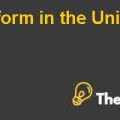Introduction
Uber-a ridesharing company started its operations in San Francisco, with an aim to offer easy travel services in the market. The company, since its initiation in 2015, targeted the US market through strong value proposition of offering a better advantage to the drivers. It considered drivers as its Partners inorder to create abetter bond amongthe different stakeholders.
In doing so, the company charged 25% on each ride. Perhaps, Uber developed a competitive edge by pursuing cost leadership strategy and volume sales earning profits while maintaining the customer satisfaction level and ultimately, achieving customer (passenger) satisfaction, increasing word of mouth and ultimately, the sales.
Though till now Uber has maintained a strong comparative position globally, however the legal law litigation and along with the unionization ofdriversrhave made it difficult for Uber to pursue the similar strategy in the market. Also the increasing competition from Lyft and Didi has made the market shrink, limiting the profit margins and also devaluingthe brandimage. Perhaps, the main issues lies in evolving and sustaining its position in theexercising markets through sustained operational base, alongwith the properstrategy to deal with the government regulations and international organizational structure and values.
In such an ambiguous situation, Uber has to develop such a strategy that would allow to maintain its distinctive brand image in the US market and attract potential drivers so as to increase the word of mouth and develop an extensive carpooling network throughout the US and other markets.
Uber Technologies Harvard Case Solution & Analysis
Problem Statement
“Uber is facing legal litigation against the business model, leading torestricted access in the markets. In addition, the companyhas failed to maintain its ethicalbrandimage in the market, leadingto controversies.Lastly, the company has started facing internal threats from drivers in the form of unionization andexternal threat from the increasing competition from the similarbusinessplayers such as Lyft.
Analysis
Since Uberhas developed a strong brandimage and global stance in the market, followingare the strategies proposed for Uber in order to deal with the driver unionization, employee satisfaction andgovernment support,so to make theplan sustainable and growing.
Operational Strategy
Under the operational strategy, Ubershould adopt a strong differentiation strategy, in which, it charges the driver’s $0.99 flat rate commission as compared to the 20% to 30% each-ride-commission charge. In addition to this and the operational strategy, the company should focus on easing and benefiting the drivers. In doing so, it should offer flexible working hours and schedules to drivers, which increases the performance and satisfaction level of the drivers, ultimately, allowing the company to gain a substantial word of mouth in the market and thus, extended customer satisfactions (riders).
Also, Under the operational strategy, Uber should focus on the core fact that by benefiting the driver through a boost strategy, in which, the rider can offer a high bid price for the offered driver from a low boost area, it can attain satisfaction from both ends, that is, the rider can get low fare rates at the peak hours as compared to other services and the drivers may receive higher fee as compared to operating in low boost areas, thus, developing a two way profit strategy..............
This is just a sample partical work. Please place the order on the website to get your own originally done case solution.










